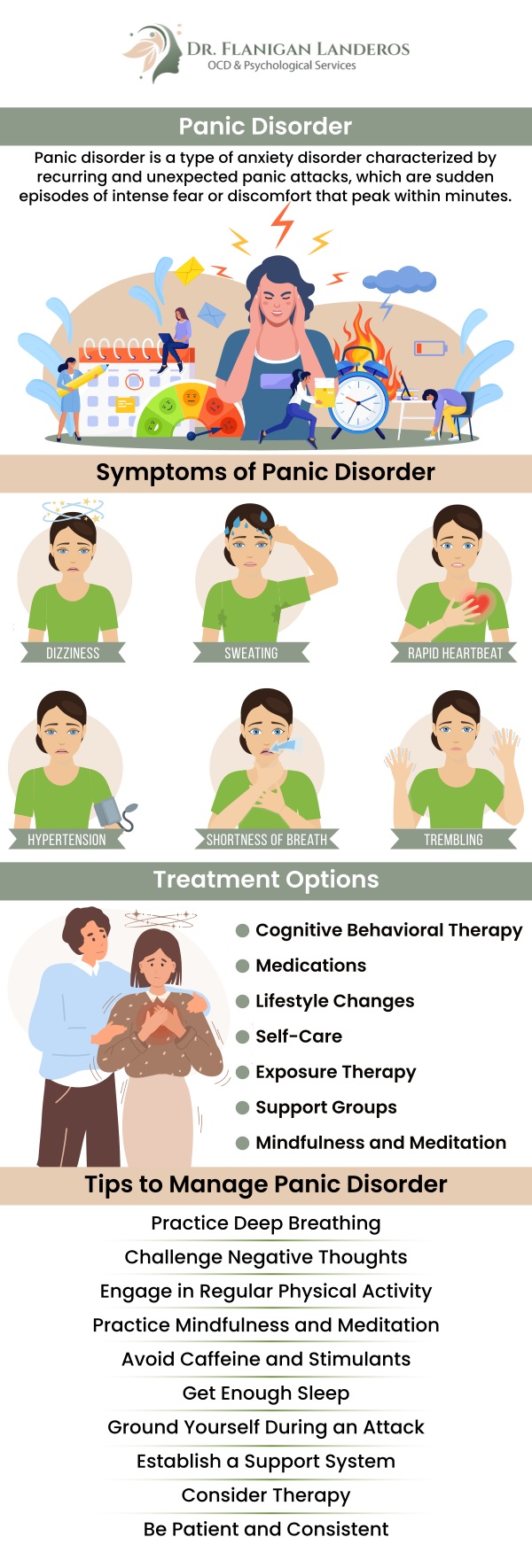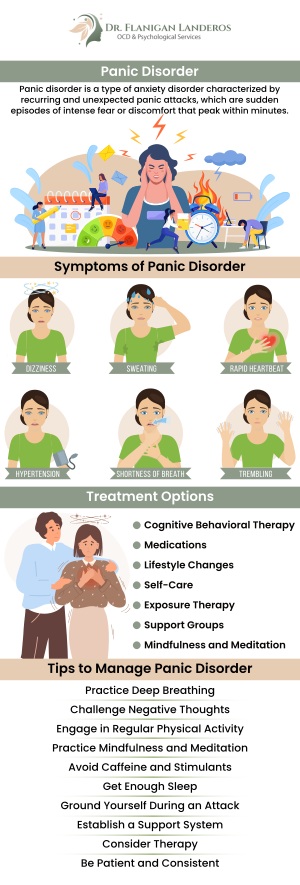Panic Disorder Treatment Specialist Serving Santa Monica, El Segundo CA
Dr. Katie Flanigan-Landeros, Clinical Psychologist, offers treatment for panic disorder, which involves recurring panic attacks marked by sudden fear or discomfort. Symptoms include a rapid heartbeat, sweating, trembling, shortness of breath, chest pain, and feelings of choking. Individuals may also experience dizziness, chills, or a fear of losing control or dying during an attack. For more information, contact us or schedule an appointment online. We are conveniently located at 400 Continental Blvd FL 6, Suite A El Segundo, CA 90245.


Table of Contents:
What is panic disorder?
What are the common symptoms of panic disorder?
What causes panic disorder?
How does panic disorder differ from a panic attack?
How does Dr. Katie Flanigan-Landeros tailor Panic Disorder treatment to meet each patient’s unique emotional and behavioral needs?
Panic disorder is a more persistent condition than a single panic attack. It involves experiencing sudden episodes of intense fear and physical symptoms like rapid heartbeat, sweating, shortness of breath, dizziness, or chest tightness. What distinguishes panic disorder is that these episodes come with the constant worry about when the next one might strike and the tendency to avoid places or activities where past attacks happened. This ongoing fear of fear itself begins to interfere with daily choices, social life, and overall sense of control. Over time, that pattern of fear and avoidance can close off entire parts of life. People may stop driving alone or refuse invitations out of anxiety about having an attack in public. Panic disorder is recognized not because the attacks are physically dangerous but because they leave behind emotional scars that shape how someone lives. Therapy aims to break that web by helping individuals reclaim agency rather than live with anxiety as a driving force.
During a panic attack, it’s common to feel the heart pounding or racing, hands shaking, chest ache, lightheadedness, tingling in the fingers, or a sudden flush or chill. Those physical sensations often trigger a fear response strong enough that many describe feeling like they might die or go mad. The full episode usually lasts just a few minutes, but it can feel like an eternity, and the emotional aftershock may linger much longer. What distinguishes a panic disorder from one isolated panic attack is the pattern, when the worry about having another attack begins to dominate thoughts, people start changing their routines and avoiding places they once loved. That anticipation creates a second set of symptoms, including restlessness, insomnia, and irritability that can persist even between episodes and reinforce the cycle of anxiety. That’s what turns a frightening moment into a life-altering condition.
There isn’t just one root cause. Biologically, some people have more reactive nervous systems, where the fight or flight response kicks in near-instantly even when no danger exists. Genetically, there’s often a family history of anxiety or panic issues. Then there are emotional and environmental factors, including stressful life transitions such as breakups, job changes, or health scares can prime someone’s brain to expect danger where none exists. Psychologically, learning plays a part. If a person has once experienced an attack in a certain place or situation, they can begin to link that environment with anxiety. Over time, the mind learns to anticipate fear, and the body follows along with these instincts, creating future panic at even subtle internal cues. Treatment considers all those layers, including physical sensitivity, past events, current thinking, and works to change the way the body and mind respond to perceived threats.
A panic attack is an acute event that involves an intense wave of fear or discomfort hitting quickly, peaking within minutes, then fading. Someone without panic disorder can have one and move on, perhaps shaken but not changed. For someone with panic disorder, the problem goes deeper. The panic attacks recur, and the fear of them starts to shape everyday life. The individual becomes consumed not just by the episodes themselves, but by the dread of what comes next. Rather than a one-off event, panic disorder becomes an ongoing concern where past attacks, ongoing fear, avoidance, and lifestyle changes become the new normal. The symptoms build on one another, making the emotional burden heavier than the attacks themselves. Therapy often focuses not only on reducing the attacks but untangling the worry, avoidance, and altered behaviors that go along with them.
Dr. Katie Flanigan-Landeros, a Clinical Psychologist serving Santa Monica El Segundo, CA, provides highly individualized care for patients experiencing Panic Disorder. She begins by developing a deep understanding of each patient’s emotional landscape, identifying specific triggers, thought patterns, and behavioral responses that contribute to panic attacks. By combining empathy with clinical precision, Dr. Flanigan-Landeros designs treatment plans that address both the physical sensations and cognitive roots of anxiety, empowering patients to regain confidence and emotional balance in their daily lives.
Targeted Cognitive Restructuring
Dr. Flanigan-Landeros helps patients recognize and reframe distorted thinking patterns that fuel fear, guiding them toward healthier, more rational responses to anxiety-provoking situations.
Mindfulness and Relaxation Training
She incorporates mindfulness, breathing, and grounding techniques to help patients manage physical symptoms of panic and stay calm during moments of distress.
Gradual Exposure and Emotional Resilience
By introducing exposure techniques at a comfortable pace, Dr. Flanigan-Landeros supports patients in confronting feared sensations or situations, reducing avoidance and building long-term emotional resilience.
Through her patient-centered, compassionate approach, Dr. Flanigan-Landeros ensures each individual feels supported, understood, and equipped with the tools to overcome panic and reclaim a sense of control in life.
Panic disorder treatment is available at Dr. Katie Flanigan-Landeros OCD & Psychological Services. For more information, contact us or schedule an appointment online. We are conveniently located at 400 Continental Blvd FL 6, Suite A El Segundo, CA 90245. We serve patients from El Segundo CA, Santa Monica CA, Inglewood CA, Gardena CA, Torrance CA, Hawthorne CA, Culver City CA, Westmont CA, West Los Angeles CA and surrounding areas.

Check Out Our 5 Star Reviews


Additional Services You May Need
▸ Anxiety
▸ Depression
▸ OCD
▸ Relationships
▸ Individual Psychotherapy
▸ Psychological Testing
▸ ADHD
▸ Telehealth
▸ Seasonal Mood Changes
▸ Cognitive Behavioral Therapy
▸ Life Transition
▸ Acceptance and Commitment Therapy (ACT)
▸ Exposure With Response Prevention (ERP)
▸ Dialectical Behavior Therapy (DBT)
▸ OCD Subtypes
▸ Perfectionism
▸ Group Therapy

Additional Services You May Need
▸ Anxiety
▸ Depression
▸ OCD
▸ Relationships
▸ Individual Psychotherapy
▸ Psychological Testing
▸ ADHD
▸ Telehealth
▸ Seasonal Mood Changes
▸ Cognitive Behavioral Therapy
▸ Life Transition
▸ Acceptance and Commitment Therapy (ACT)
▸ Exposure With Response Prevention (ERP)
▸ Dialectical Behavior Therapy (DBT)
▸ OCD Subtypes
▸ Perfectionism
▸ Group Therapy



